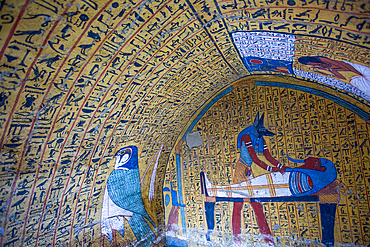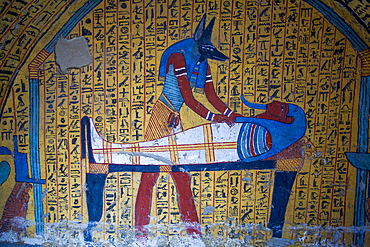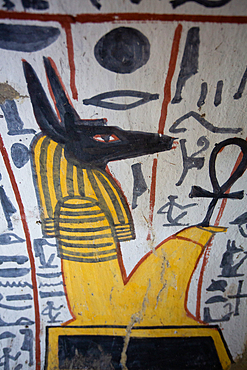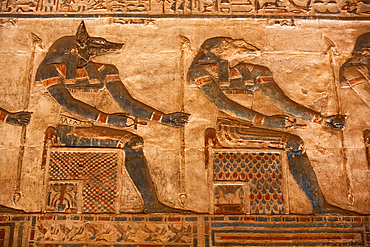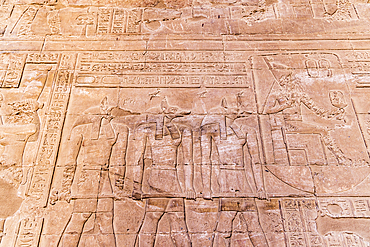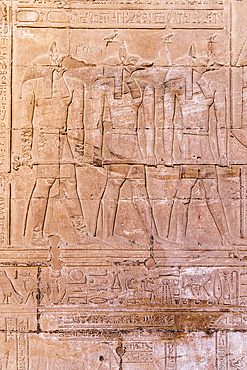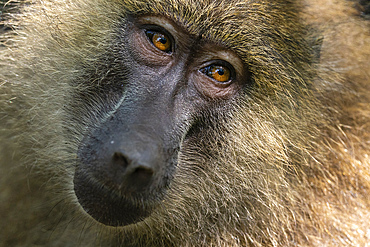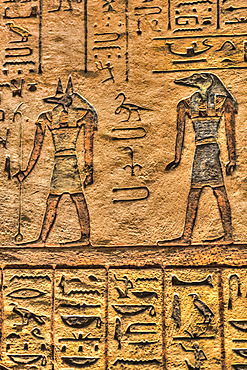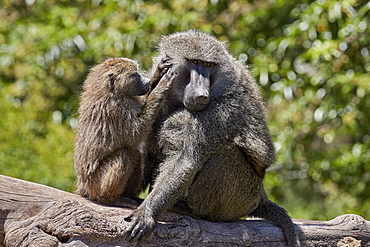Recent searches
Loading...
801-4237 - Image of the God Anubis, Paintings and Relief, Tomb of Nefertari, QV66, Valley of the Queens, Ancient Thebes, UNESCO World Heritage Site, Luxor, Egypt
743-2221 - Olive baboon (Papio anubis), Shompole, Kenya
801-4062 - Statue of God Anubis, Ramesseum, Memorial Temple of Pharoah Ramesses II, (13th Century BC), Ancient Thebes, UNESCO World Heritage Site, Luxor, Egypt
801-4030 - Image of God Anubis, Wall Paintings, Tomb of Menna, TT69, Tombs of the Nobles, Ancient Thebes, UNESCO World Heritage Site, Luxor, Egypt
801-3960 - God Anubis Tending to Pharaoh (far wall), Wall Paintings, Tomb of Khaemteri, TT220, Deir el-Medina Tombs (Worker Tombs), Thebes, UNESCO World Heritage Site, Luxor, Egypt
801-3959 - God Anubis Tending to Pharaoh (far wall), Wall Paintings, Tomb of Khaemteri, TT220, Deir el-Medina Tombs (Worker Tombs), Thebes, UNESCO World Heritage Site, Luxor, Egypt
801-3958 - God Anubis Tending to Pharaoh, Wall Paintings, Tomb of Khaemteri, TT220, Deir el-Medina Tombs (Worker Tombs), Thebes, UNESCO World Heritage Site, Luxor, Egypt
801-3952 - God Anubis, Wall Paintings, Tomb of Nebenmaat, TT219, Tomb of Deir el-Medina Tombs (Worker Tombs), Thebes, UNESCO World Heritage Site, Luxor, Egypt
801-3950 - God Anubis Facing Pharaoh, Wall Paintings, Tomb of Nebenmaat, TT219, Tomb of Deir el-Medina Tombs (Worker Tombs), Thebes, UNESCO World Heritage Site, Luxor, Egypt
801-3948 - God Anubis Performing the Opening the Mouth Ritual on Pharaoh, Wall Paintings, Tomb of Nebenmaat, TT219, Tomb of Deir el-Medina Tombs (Worker Tombs), Thebes, UNESCO World Heritage Site, Luxor, Egypt
801-3934 - God Anubis (left), Goddess Sekhmet (right), Reliefs, Sanctuary, Dendera Temple of Hathor, UNESCO World Heritage Site (tentative list), Quena, Egypt
801-3884 - Image of God Anubis, Tomb of Pashedu, TT3, Deir el-Medina Tombs (Worker Tombs), Thebes, UNESCO World Heritage Site, Luxor, Egypt
1366-413 - Edfu, Aswan, Egypt. Carving of the god Anubis in the Temple of Horus at Edfu.
1366-410 - Edfu, Aswan, Egypt. Carving of the god Anubis in the Temple of Horus at Edfu.
1366-409 - Edfu, Aswan, Egypt. Carving of the god Anubis in the Temple of Horus at Edfu.
741-6168 - Olive Baboon (Papio anubis), Lake Manyara National Park, Tanzania, East Africa, Africa
741-6166 - Olive Baboon (Papio anubis), Lake Manyara National Park, Tanzania, East Africa, Africa
741-6167 - Olive Baboon (Papio anubis), Lake Manyara National Park, Tanzania, East Africa, Africa
741-6163 - Portrait of an olive baboon (Papio anubis), Lake Manyara National Park, Tanzania, East Africa, Africa
741-6169 - Olive Baboon (Papio anubis), Lake Manyara National Park, Tanzania, East Africa, Africa
741-6165 - Portrait of an olive baboon (Papio anubis), Lake Manyara National Park, Tanzania, East Africa, Africa
741-6161 - Olive baboon (Papio anubis) grooming, Lake Manyara National Park, Tanzania, East Africa, Africa
741-6162 - Olive baboon (Papio anubis) grooming, Lake Manyara National Park, Tanzania, East Africa, Africa
741-6164 - Portrait of an olive baboon (Papio anubis), Lake Manyara National Park, Tanzania, East Africa, Africa
1116-50668 - Gods Anubis (left) and Sobek (right), Tomb of Ramses III, KV #11, Valley of the Kings, UNESCO World Heritage Site; Luxor, Egypt
1116-50361 - Olive baboon (Papio anubis) sits on bank facing camera, Grumeti Serengeti Tented Camp, Serengeti National Park; Tanzania
1116-50362 - Olive baboon (Papio anubis) sits cuddling baby on bank, Grumeti Serengeti Tented Camp, Serengeti National Park; Tanzania
1116-50363 - Olive baboon (Papio anubis) sits cuddling baby beside another, Grumeti Serengeti Tented Camp, Serengeti National Park; Tanzania
832-390789 - Olive baboon (Papio anubis) jumps from tree to tree, Solio Ranch Wildlife Sanctuary, Kenya, Africa
741-5904 - Olive Baboon (Papio anubis), Seronera, Serengeti National Park, Tanzania, East Africa, Africa
741-5905 - Olive Baboon (Papio anubis), Seronera, Serengeti National Park, Tanzania, East Africa, Africa
1112-5449 - Adult olive baboon (Papio anubis) carrying juvenile on its back in Tarangire National Park, Tanzania, East Africa, Africa
1112-5451 - Adult olive baboon (Papio anubis), Ngorongoro Conservation Area, Tanzania, East Africa, Africa
1112-5452 - Olive baboons (Papio anubis) grooming each other in Ngorongoro Conservation Area, Tanzania, East Africa, Africa
1112-5453 - Olive baboons (Papio anubis) grooming each other in Ngorongoro Conservation Area, Tanzania, East Africa, Africa
1112-5450 - Olive baboons (Papio anubis) grooming each other in Ngorongoro Conservation Area, Tanzania, East Africa, Africa
801-2791 - Reliefs, Chapel of Anubis, Hatshepsut Mortuary Temple (Deir el-Bahri), UNESCO World Heritage Site, Luxor, Thebes, Egypt, North Africa, Africa
801-2790 - Reliefs, Chapel of Anubis, Hatshepsut Mortuary Temple (Deir el-Bahri), UNESCO World Heritage Site, Luxor, Thebes, Egypt, North Africa, Africa
801-2792 - Reliefs, Chapel of Anubis, Hatshepsut Mortuary Temple (Deir el-Bahri), UNESCO World Heritage Site, Luxor, Thebes, Egypt, North Africa, Africa
801-2794 - Reliefs, Chapel of Anubis, Hatshepsut Mortuary Temple (Deir el-Bahri), UNESCO World Heritage Site, Luxor, Thebes, Egypt, North Africa, Africa
764-5860 - Olive baboon (Papio cynocephalus anubis) juvenile grooming an adult male, Ngorongoro Crater, Tanzania, East Africa, Africa
764-5859 - Olive Baboon (Papio cynocephalus anubis) juvenile grooming an adult male, Ngorongoro Crater, Tanzania, East Africa, Africa
764-5792 - Juvenile olive baboon (Papio cynocephalus anubis) in a tree, Ngorongoro Crater, Tanzania, East Africa, Africa
1185-328 - Olive Baboon (Anubis baboon), Uganda, Africa
1185-335 - Olive Baboon (Anubis baboon), Ishasha, Uganda, Africa
741-5240 - Olive baboons (Papio anubis) looking at the camera, Kalama Conservancy, Samburu, Kenya, East Africa, Africa
1249-8 - Olive baboon with baby on back (Papio anubis), Arusha National Park, Tanzania, East Africa, Africa
801-1672 - Bas-relief of the God Anubis on left and Ramses II on right, Temple of Seti I, Abydos, Egypt, North Africa, Africa
801-1668 - Bas-relief of the God Anubis on left, with the Pharaoh Seti I, Temple of Seti I, Abydos, Egypt, North Africa, Africa
801-1671 - Bas-relief of the God Anubis, Temple of Seti I, Abydos, Egypt, North Africa, Africa
801-1606 - Relief depicting the God Anubis, Temple of Horus, Edfu, Egypt, North Africa, Africa
764-4133 - Olive baboon (Papio cynocephalus anubis) infant riding on its mother's back, Serengeti National Park, Tanzania, East Africa, Africa
764-4134 - Olive baboon (Papio cynocephalus anubis) infant riding on its mother's back, Serengeti National Park, Tanzania, East Africa, Africa
764-4135 - Olive baboon (Papio cynocephalus anubis) infant and mother, Serengeti National Park, Tanzania, East Africa, Africa
764-3954 - Olive baboon (Papio cynocephalus anubis) nursing, Serengeti National Park, Tanzania, East Africa, Africa
817-440446 - An Egyptian Limestone Stele 1st millennium BCE depicting Isis, Anubis and Ptah.
817-410339 - Olive baboon, Papio Anubis, Olive baboons are widespread throughout equatorial Africa and are found in 25 countries. From the west coast of Africa moving eastward. In the picture there is a mother with a juvenile, the mother is eating some grass and the s. Olive baboon, Papio Anubis, Olive baboons are widespread throughout equatorial Africa and are found in 25 countries. From the west coast of Africa moving eastward. In the picture there is a mother with a juvenile, the mother is eating some grass and the small one is in its back. In Uganda, olive baboons live in open woodland bordered by savannah and in evergreen tropical forests At Queen Elizabeth National Park, situated in Uganda, near the border of Democratic Republic of Congo, the habitat is characterized by dense forest, coarse wet grass, short grass and open grassland. Olive baboons consume a wide variety of foods and they can adapt to very different kind of habitats, from desert to mountain forest because they have many different strategies and habilities to extract food and nutrients. Baboons are omnivores and consume a huge variety of vegetables, insects, birds, eggs, and vertebrates including other primates. The Olive Baboon is one of the largest baboons, with the males being larger than the females. Their body length is 60, 86 cm, their tail length is 41, 58 cm and they weigh between 22 and 37 Kg. There is some geographical variation in average size. They have an olive green/grey coat that covers their bodies and a black face. The males have large canine teeth where as the teeth of females are much smaller. They move around on all four limbs. They live in troops of males and females that consist of between 20 and 50 members. The picture was taken in Ugande, in the Queen Elizabeth National Park, near the Kazinga channel., Uganda, Africa, East-africa
741-4319 - Olive baboon (Papio anubis), Masai Mara, Kenya, East Africa, Africa
764-2865 - Olive baboon (Papio cynocephalus anubis), Serengeti National Park, Tanzania, East Africa, Africa
764-2864 - Two young Olive baboons (Papio cynocephalus anubis), Serengeti National Park, Tanzania, East Africa, Africa
817-260757 - Olive Baboon Papio anubis, Kibale forest, Uganda, East Africa
741-3627 - Olive baboon (Papio anubis), Masai Mara, Kenya, East Africa, Africa
741-3661 - Olive baboon (Papio anubis), Samburu National Park, Kenya, East Africa, Africa
764-1483 - Mother and infant Olive Baboon (Papio cynocephalus anubis), Masai Mara National Reserve, Kenya, East Africa, Africa
764-1379 - Olive baboon (Papio cynocephalus anubis) mother and infant, Samburu National Reserve, Kenya, East Africa, Africa
764-1351 - Olive baboon (Papio cynocephalus anubis) mother and infant, Serengeti National Park, Tanzania, East Africa, Africa
764-1104 - Olive baboon (Papio cynocephalus anubis) infant, Samburu National Reserve, Kenya, East Africa, Africa
764-1103 - Olive baboon (Papio cynocephalus anubis), Samburu National Reserve, Kenya, East Africa, Africa
764-1102 - Olive baboon (Papio cynocephalus anubis) mother and infant, Samburu National Reserve, Kenya, East Africa, Africa
764-1101 - Olive baboon (Papio cynocephalus anubis) mother and infant, Samburu National Reserve, Kenya, East Africa, Africa
764-1181 - Young,male olive baboon (Papio cynocephalus anubis) sitting atop a tree trunk, Samburu National Reserve, Kenya, East Africa, Africa
764-897 - Olive baboon (Papio cynocephalus anubis) infant riding on its mothers chest, Serengeti National Park, Tanzania, East Africa, Africa
764-900 - Olive baboon (Papio cynocephalus anubis) eating grass, Serengeti National Park, Tanzania, East Africa, Africa
764-902 - Young olive baboon (Papio cynocephalus anubis), Serengeti National Park, Tanzania, East Africa, Africa
764-906 - Olive baboon (Papio cynocephalus anubis), Serengeti National Park, Tanzania, East Africa, Africa
764-907 - Olive baboon (Papio cynocephalus anubis) infant riding on its mother's back, Serengeti National Park, Tanzania, East Africa, Africa
764-908 - Olive baboon (Papio cynocephalus anubis) infant riding on its mother's back, Serengeti National Park, Tanzania, East Africa, Africa
764-909 - Olive baboon (Papio cynocephalus anubis) infant riding on its mother's back, Serengeti National Park, Tanzania, East Africa, Africa
764-936 - Olive baboon (Papio cynocephalus anubis) mother and infant, Samburu National Reserve, Kenya, East Africa, Africa
764-937 - Olive baboon (Papio cynocephalus anubis), Samburu National Reserve, Kenya, East Africa, Africa
764-710 - Young olive baboon (Papio cynocephalus anubis), Lake Nakuru National Park, Kenya, East Africa, Africa
764-711 - Young olive baboon (Papio cynocephalus anubis), Lake Nakuru National Park, Kenya, East Africa, Africa
764-689 - Olive baboon (Papio cynocephalus anubis) baby riding on its mother's back, Serengeti National Park, Tanzania, East Africa, Africa
764-709 - Infant olive baboon (Papio cynocephalus anubis), Lake Nakuru National Park, Kenya, East Africa, Africa
764-712 - Infant olive baboon (Papio cynocephalus anubis) nursing, Lake Nakuru National Park, Kenya, East Africa, Africa
764-515 - Infant olive baboon (Papio cynocephalus anubis), Lake Nakuru National Park, Kenya, East Africa, Africa
764-298 - Infant olive baboon (Papio cynocephalus anubis) sitting in its mother's lap and looking at the camera, Serengeti National Park, Tanzania, East Africa, Africa
764-339 - Olive baboon (Papio cynocephalus anubis) nursing young, Samburu Game Reserve, Kenya, East Africa, Africa
764-338 - Young male olive baboon (Papio cynocephalus anubis) sitting atop a tree trunk looking at the camera, Samburu Game Reserve, Kenya, East Africa, Africa
744-5 - The king in the form of the god Anubis, from the tomb of Tutankhamun, discovered in the Valley of the Kings, Thebes, Egypt, North Africa, Africa
764-147 - Olive baboon mother and baby (Papio cynocephalus anubis), Masai Mara National Reserve, Kenya, East Africa, Africa
764-149 - Olive baboon female and infant (Papio cynocephalus anubis), Tarangire National Park, Tanzania, East Africa, Africa
39-4906 - Mural showing the god Anubis leaning over mummy of Ramses II, in the Tomb of Sinjin, chief artist to Ramses II, Deir el Medina, Thebes, UNESCO World Heritage Site, Egypt, North Africa, Africa
120-772 - Tomb of Sennedjem, Deir El Medina, Thebes, UNESCO World Heritage Site, Egypt, North Africa, Africa
450-3816 - Tomb painting of the pharaoh Ramses I with the god Anubis, Valley of the Kings, UNESCO World Heritage Site, West Bank, Luxor, Thebes, Egypt, North Africa, Africa
450-3814 - Relief of the pharaoh Ramses III and the god Anubis, Medinet Habu, UNESCO World Heritage Site, West Bank, Thebes, Egypt, North Africa, Africa
You reached the end of search results





